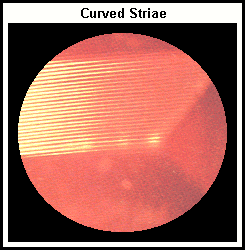Professional Gemologist Certification Course
Identifying Inclusions Found in Synthetic Gems
Curved Striae
Flame-fusion grown corundum — rubies and sapphires — are among the most common synthetic gem materials. Inexpensive to manufacture, these lab-created stones come in a variety of colors and have the same exceptional durability as their natural counterparts. Therefore, gemologists must learn to identify these synthetic gems.
If your initial refractive index (RI) reading points towards corundum, you should next determine if your gem is natural or synthetic. First, examine the gem’s cut. Cheap lab-created rubies and sapphires don’t get the care natural stones do. You’ll find poor workmanship in synthetic corundum. Next, examine the interior. Synthetic corundum will lack crystal or silk inclusions. They’ll have clear interiors. However, they do have a unique type of inclusion: curved striae.
With diffused lighting, look for curved or straight growth lines in the interior of a stone. Natural corundum will only have straight growth lines, never curved lines. Curved lines or striae are difficult to distinguish, because their curvature is very subtle. Look at the following images. The picture on the left shows curved striae on the pavilion main facets of an emerald-cut gem.
…Donald Clark, CSM IMG
The late Donald Clark, CSM founded the International Gem Society in 1998. Donald started in the gem and jewelry industry in 1976. He received his formal gemology training from the Gemological Institute of America (GIA) and the American Society of Gemcutters (ASG). The letters “CSM” after his name stood for Certified Supreme Master Gemcutter, a designation of Wykoff’s ASG which has often been referred to as the doctorate of gem cutting. The American Society of Gemcutters only had 54 people reach this level. Along with dozens of articles for leading trade magazines, Donald authored the book “Modern Faceting, the Easy Way.”
Never Stop Learning
When you join the IGS community, you get trusted diamond & gemstone information when you need it.
Get Gemology Insights
Get started with the International Gem Society’s free guide to gemstone identification. Join our weekly newsletter & get a free copy of the Gem ID Checklist!
